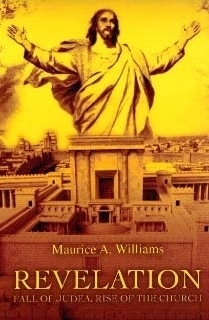
REVELATION: FALL OF JUDEA, RISE OF THE CHURCH
Maurice A. Williams
iUniverse (2008)
ISBN 9780595484294
Reviewed by Richard R. Blake for Reader Views (1/09)
On www.readersviews.com
Maurice A. Williams develops a preterist interpretation in his book “Revelation: Fall of Judea, Rise of the Church.” He takes the reader back to the first century to experience with John the Baptist his visions and symbolic images.
Williams joins the ranks with other Biblical scholars who attribute the authorship of Revelation chapters four through eleven to John the Baptist.
Advocates of the preterist viewpoint, including Williams, maintain that many of the predicted visions were meant for the people who first heard them preached. This is a profound, thought-provoking approach to an interpretation refuted or overlooked by many evangelical Biblical scholars today.
Williams interpretation of the four winds found in chapters eight, verses six through twelve goes against the more popularly accepted view of the “great tribulation” promoted by the futurists. He strongly believes that Christ’s Kingdom is already here. He goes on to detail the historical events that followed the crucifixion of Christ in Judea. He discusses the cost of our freedom of choice, and the suffering and persecution of martyrdom. He uses a scholarly style in his presentation which helps substantiate his findings and conclusions. Chapters twelve through fourteen of Revelation gives a description of the birth of the Church, those who have accepted the Messiah, and predicts the hostility of Satan against the promised Christ. Williams carefully details the involvement of Rome leading up to the Fall of Judea and her “great tribulation.”
Williams cites passages from the Old Testament prophecies, from earlier traditional writings of theologians and historians to support his conclusions. Some of what he presents as fact may be considered tradition, conjecture, or speculation by other students of Revelation.
Detailed maps and illustrations add a visual impact to the narrative which aids the reader in understanding the geographical descriptions, battle strategies, the destruction of the temple, the final war with Rome, and the fall of Jerusalem.
An extensive and impressive bibliography supports the evidence of thorough and careful research Williams has done in preparation of this treatise. Recognized Biblical and historical scholars are representative of the diverse theological spectrum included, both classic and contemporary.
As with many previous works on the Book Revelation, Williams provides fresh insights, raises new theories, with numerous unanswered questions. Students of the book of Revelation will enjoy Maurice A. William’s innovative presentation whether preterist, futurist, or those who lean toward a spiritual or allegorical interpretation. The book will stimulate your thinking as you ponder with the prophets the possibilities and plan of God for the future of His kingdom.
Williams writes with conviction. He warns of judgment to come on the Gentile nations who are rejecting the second coming of the Messiah even as Judea experienced her “great tribulation” at the end of 1,000 years Christendom. He presents his case in an orderly, logical way, giving a comparison of futurist and preterist conclusions allowing the reader to consider both interpretations in light of the scriptures and the dramatic current events of the first century. “Revelation: Fall of Judea, Rise of the Church” by Maurice A. Williams is strong writing, clearly written, with conviction. Williams has opened my eyes to an amazing new appreciation of first century followers of Christ.
Back to Previous Page